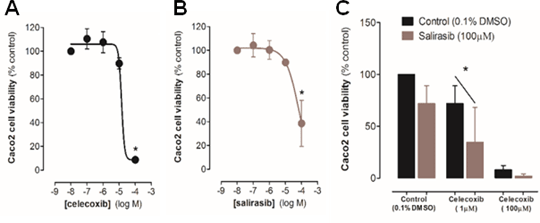Synergistic/Additive Effects of COX-2 Inhibitors and Ras Inhibitors on Colon Cancer Cell Viability
Introduction: Cyclo-oxygenase (COX)-2 inhibitors, which include Nurofen® (ibuprofen), Celebrex® (celecoxib) and Mobic® (meloxicam) are amongst the most commonly used drugs worldwide. They are used to treat pain and inflammation and have shown tobe effectiveas a preventative therapy and treatment for colon cancer (1), but their use, especially in cancer prevention, has been limited by cardiovascular toxicity (2). We have previously performed microarray analysis of tissue from COX-2-deficient mice and found a novel association between COX-2 and Ral guanine nucleotide dissociation stimulator-like 1 (Rgl1) which was down regulated by COX-2 deletion. Similar findings were obtained when the effects of COX-2 inhibition was studied using an online microarray database mining approach(3). Rgl1 is an effector of Ras, the most common oncogene in human cancer. As such, we hypothesized that down-regulation of Rgl1 by COX-2 inhibitors could contribute to their anti-cancer effects. Methods: To test this, we set up an in vitro human colon cancer cell model (Caco2). Cells were seeded at 3,000 cells/well in DMEM media and after 2 hrs, treated with the selective COX-2 inhibitor, celecoxib (0.1-100µM), the Ras pathway inhibitor, salirasib (0.1-100µM), or vehicle (0.1% DMSO). In some cases, celecoxib (1,100µM) was added in the presence of salirasib (100µM). After 24, 96 and 168 hrs, cell viability was assessed using an alamarBlue® assay which measures metabolic activity. Results: Celecoxib and salirasib did not alter Caco2 cell viability at 24hrs but both drugs reduced viability at 96hrs and 168hrs. At 96 hrs, celecoxib (Figure 1A) and salirasib (Figure 1B) produced a concentration-dependent reduction with celecoxib giving almost complete inhibition of cell viability at 100µM and salirasib giving ~60% reductionat 100µM. To assess whether the inhibitory effects of celecoxib were through the Ras/Rgl1 pathway, its effect on cell viability were tested in the presence and absence of salirasib (100uM). As previously, celecoxib produced concentration-dependent inhibition of Caco2 cell viability, which was significantly increased in the presence of salirasib (Figure 1C).
Figure 1 Cell viability of Caco2 cells treated with(A) celecoxib (COX-2 inhibitor) and (B) salirasib (Ras inhibitor) (C) Combination effects of both drugs. For (A&B), *, p<0.05 by one way repeated measures ANOVA with Sidaks’s post-test vs. vehicle. For (C),* p<0.05 for the effect salirasib by two way repeated measures ANOVA with Sidaks’s post-test. n=3.
Conclusions: Together these studies demonstrate that COX-2 and Ras pathway inhibitors produce their inhibitory effect on colon cancer cell viability through separate pathways. However, inhibitors of Ras and COX-2 pathways have powerful additive or synergistic effects, which may suggest this drug combination may be valuable in the treatment of colon cancer. References (1) Hahn E et al. (2010) Dig Dis; 28(4-5): 585-9. (2) Mukherjee D et al. (2001). JAMA .;286(8): 954-9. (3) Mazi S et al. (2014) pa2online.org/abstract/abstract.jsp?abid=32589&kw=rgl1&cat=-1&period=-1
|



